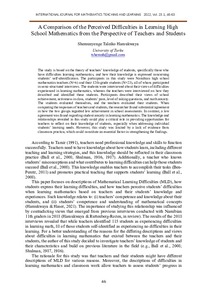A Comparison of the Perceived Difficulties in Learning High School Mathematics from the Perspective of Teachers and Students
Hamukwaya Shemunyenge Taleiko
https://urn.fi/URN:NBN:fi-fe2022091258816
Tiivistelmä
The study is based on the theory of teachers’ knowledge of students, specifically those who have difficulties in learning mathematics, and how their knowledge is expressed in relation to students’ self-identification. The participants in this study were Namibian high school mathematics teachers [N=6] and their twelfth-graders [N=23], all of whom participated in semi-structured interviews. Students were interviewed about their views on difficulties experienced in learning mathematics whereas teachers were interviewed on the criteria used when identifying these students. Participants asserted their views on school achievement, activeness in class, students’ pace, level of asking questions, and maths anxiety. Students evaluated themselves and teachers evaluated their students. Comparing the responses of teachers and students, substantial agreement was found between them regarding low achievement in school assessments, whereas low agreement was found in terms of student anxiety in learning mathematics. The knowledge and relationship revealed in this study might play a critical role in providing opportunities for teachers to reflect on their knowledge of students especially when addressing individual students’ needs to improve their learning. However, this study was limited by a lack of evidence from classroom practice and this could an essential factor to help strengthen the findings.
Kokoelmat
- Rinnakkaistallenteet [19207]
